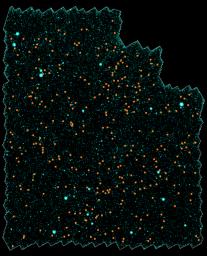
PIA08509: Galaxies Gather at Great Distances


|
| Mission: |
Spitzer Space Telescope
|
| Instrument: |
IRAC
Mosaic-I Camera
Mayall 4-Meter Telescope
|
| Product Size: |
1114 x 1380 pixels (w x h) |
| Produced By: |
California Institute of Technology
|
|
Full-Res TIFF:
|
PIA08509.tif (4.618 MB)
|
|
Full-Res JPEG:
|
PIA08509.jpg (365.3 kB)
|
|
Click on the image above to download a moderately sized image in
JPEG format (possibly reduced in size from original)
|
Distant Galaxy Cluster Infrared Survey Poster
- Original Caption Released with Image:
-
| 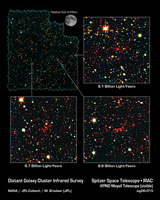 |
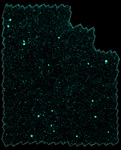 | 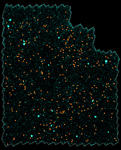 |
Bird's Eye
View Mosaic | Bird's Eye View
Mosaic with Clusters |
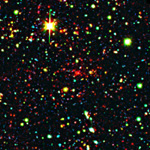 | 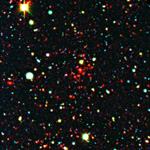 | 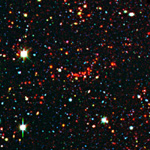 |
| 9.1 Billion Light-Years | 8.7 Billion Light-Years | 8.6 Billion Light-Years |
Astronomers have discovered nearly 300 galaxy clusters and groups, including almost 100 located 8 to 10 billion light-years away, using the space-based Spitzer Space Telescope and the ground-based Mayall 4-meter telescope at Kitt Peak National Observatory in Tucson, Ariz. The new sample represents a six-fold increase in the number of known galaxy clusters and groups at such extreme distances, and will allow astronomers to systematically study massive galaxies two-thirds of the way back to the Big Bang.
A mosaic portraying a bird's eye view of the field in which the distant clusters were found is shown at upper left. It spans a region of sky 40 times larger than that covered by the full moon as seen from Earth. Thousands of individual images from Spitzer's infrared array camera instrument were stitched together to create this mosaic. The distant clusters are marked with orange dots.
Close-up images of three of the distant galaxy clusters are shown in the adjoining panels. The clusters appear as a concentration of red dots near the center of each image. These images reveal the galaxies as they were over 8 billion years ago, since that's how long their light took to reach Earth and Spitzer's infrared eyes.
These pictures are false-color composites, combining ground-based optical images captured by the Mosaic-I camera on the Mayall 4-meter telescope at Kitt Peak, with infrared pictures taken by Spitzer's infrared array camera. Blue and green represent visible light at wavelengths of 0.4 microns and 0.8 microns, respectively, while red indicates infrared light at 4.5 microns.
Kitt Peak National Observatory is part of the National Optical Astronomy Observatory in Tuscon, Ariz.
Image Credit:
NASA/JPL-Caltech/NOAO
Image Addition Date:
2006-06-05

 Planetary Data System
Planetary Data System











